Article by Wayne Gillam, Photos by Ryan Hoover | UW ECE News
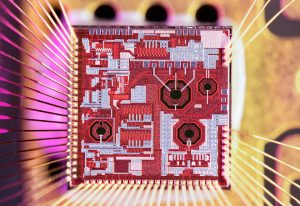
A UW ECE graduate student research team, advised and led by Professor Chris Rudell, has designed an innovative computer chip that can send and receive large amounts of data at high speeds while minimizing signal distortion and conserving the limited spectrum available for wireless communication. Shown above: A close-up view of the chip designed by the team.
Imagine the roar of a crowd while sitting in a football stadium during a touchdown. At that moment of peak excitement, envision trying to carry on a conversation with a friend on the opposite side of the stadium. You’re using a megaphone to be heard across the distance and the noise, but your friend is whispering. And on top of that, you’re both talking at the same time. Sounds impossible? It probably is. However, in the near future, wireless communication technologies, such as Bluetooth, WiFi, and cellular radios, will face a challenge very similar to this hypothetical scenario, but in the open-air, electromagnetic spectrum.
With each passing year, the number of wireless devices owned by consumers is steadily increasing, creating more congestion over the airwaves — much like adding to the number of noisy fans in our imaginary football stadium. This unfortunate reality can lead to problems with signal interference between wireless devices, so engineers are motivated to look for ways of making better use of a finite amount of shared spectrum allocated for wireless communication. Currently, one avenue being pursued seeks to explore new ways of transmitting and receiving signals using the same carrier frequency to both talk (transmit) and listen (receive). This would cut in half the amount of shared spectrum that is occupied by one device. But this method of communication brings up a thorny challenge — coping with signal noise and distortion caused by transmitting and receiving at the same time, especially for mobile technologies attempting to communicate over long distances.
“The impact of this chip will extend not only to all wireless devices, but also to many other devices that serve as an interface between the real and digital worlds. At the end of the day, its going to be very broad in its application.” — UW ECE Professor Chris Rudell
The challenge grows as a mobile device approaches the edge of its signal range. A device transmitting and receiving at the same time and on the same carrier frequency must be able to “listen” carefully to both detect and receive a faint signal sent from a long distance, while simultaneously transmitting a powerful signal back to the other user to establish two-way communication. This is akin to shouting as loudly as possible at someone while they are whispering from the far end of a long hallway, or from across a football stadium, like in the scenario described above.
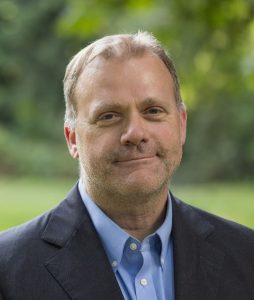
UW ECE Professor Chris Rudell
Now, a UW ECE graduate student research team, advised and led by Professor Chris Rudell, has found a way to help address this daunting challenge with a hardware solution fabricated on a single computer chip. Over the past three years, the team has designed this chip for wireless communication, engineering it to send and receive large amounts of data at high speeds on the same carrier frequency while also minimizing signal distortion. They described their work in a recent paper published in the IEEE Journal of Solid-State Circuits.
“The type of chip we developed is very important, and that’s because signal interference is only becoming worse as time goes on. As the number of electronic and wireless devices increases, the interference patterns that exist out there are becoming increasingly problematic,” Rudell said. “They really limit the bandwidth that can be achieved: the data rate, the range, the reliability of the wireless connection and the performance demanded by the end user.”
Rudell’s research team included graduate students Xichen Li, Yi-Hsiang Huang and Fucheng Yin* (BSEE ‘18, MSEE ‘21). The promise of their work was recognized early on, with Li and Huang both receiving a Qualcomm Innovation Fellowship for the initial stages of the research. The team also received support from the Washington Research Foundation and UW CoMotion. And because this is innovative work important to the semiconductor industry, the group received funding and support from the Semiconductor Research Corporation (SRC)/Intel, as well as Qualcomm, Boeing, the Center for Design of Analog-Digital Integrated Circuits (CDADIC), and Marvell Technology Group.
In September 2023, the research team received an Institute of Electrical and Electronics Engineers (IEEE) European Solid-State Circuits Conference (ESSCIRC) Best Student Paper Award in Lisbon, Portugal, which recognized the merit of their work on an international stage.
“The ESSCIRC Award validates the quality of our research and demonstrates acceptance by our peers worldwide,” Rudell said. “It shows that the community perceives our work as cutting edge, and I personally find that very rewarding.”
Improved data capacity, speed and signal clarity
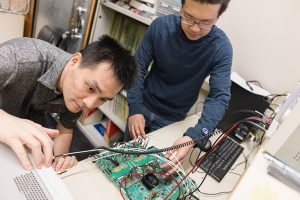
UW ECE graduate students Yi-Hsiang Huang (left) and Xichen Li (right) working in the lab of Professor Chris Rudell
The chip the team designed has the potential to improve data capacity, speed and signal clarity for almost every type of wireless communication, both short and long range. The advance is especially important for long-promised technologies, such as self-driving cars, which can be thought of as mobile devices that need to send, receive, and process large amounts of wireless data across long distances, and at lightning speed. Other wireless communication devices and applications that could benefit from this new chip include smartphones; laptops; 5G and 6G cellular technologies; medical imaging techniques, such as magnetic resonance imaging (MRI) and positron emission tomography (PET); and new and emerging types of data-intensive electronic interfaces for implantable biomedical applications, such as brain-computer interfaces.
This chip is an “analog, mixed-signal, and radio-frequency (RF) chip,” which means that it acts as an interface between analog and digital signals, or put another way, the chip acts as a bridge between radio signals carried over the airwaves and the digital electronics inside a wireless device. The chip also uses digital computation to reduce signal distortion. That is not unique in itself; however, this chip can improve signal clarity while handling much more data at faster speeds than most of its counterparts in other research labs across the globe.
“This is one of the widest bandwidth, self-interference cancellation radios on a chip of its type,” Rudell said. “We use digital computation to assist the analog performance and address the technical challenges from a top-down approach by exploring the overall radio system down to the circuit block level. This yields a solution that minimizes signal distortion, is more energy efficient and is highly programmable, allowing the System-on-a-Chip, or ‘SoC,’ to tune the circuits for a wide range of radio applications.”
Machine learning, mass production and commercialization
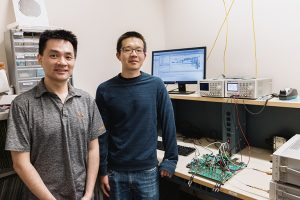
Yi-Hsiang Huang (left) and Xichen Li (right)
Looking toward the future, Rudell said that he sees machine learning playing a key role in the chip’s development. Many fast, complex calculations will be necessary to continuously tune the chip circuits for signal interference cancellation while the device moves through a vast range of physical positions and different environments. Rudell is planning to build an updated version of the chip that uses machine learning for this purpose, and he is currently in conversations with organizations that could fund and support this next step in the chip’s development.
Also being planned is mass production of the chip. Rudell is looking into commercializing this technology, and he noted the challenges involved with bringing a new chip design into a wide range of different manufacturing conditions. To be commercially viable at a large scale, a chip such as this needs to be mass produced in quantities ranging from millions to billions. In addition, each chip must work smoothly over long periods of time despite changes in environmental conditions and variations in temperature and battery supply voltage. Despite these hurdles, Rudell said he is confident that a future iteration of this chip will make its way to the marketplace within two to four years.
“There are so many different types of things that could benefit from this chip technology,” Rudell said. “You have wireless transceivers, radar, cable set top boxes, medical imaging applications, and more. The impact of this chip will extend not only to all wireless devices, but also to many other devices that serve as an interface between the real and digital worlds. At the end of the day, it’s going to be very broad in its application.”
For more information about the research described in this article, read “A 2.4GHz Full-Duplex Transceiver with Broadband (+120MHz), Linearity-Calibrated and Long-Delayed Self-Interference Cancellation” in the IEEE Journal of Solid-State Circuits, or contact UW ECE Professor Chris Rudell.
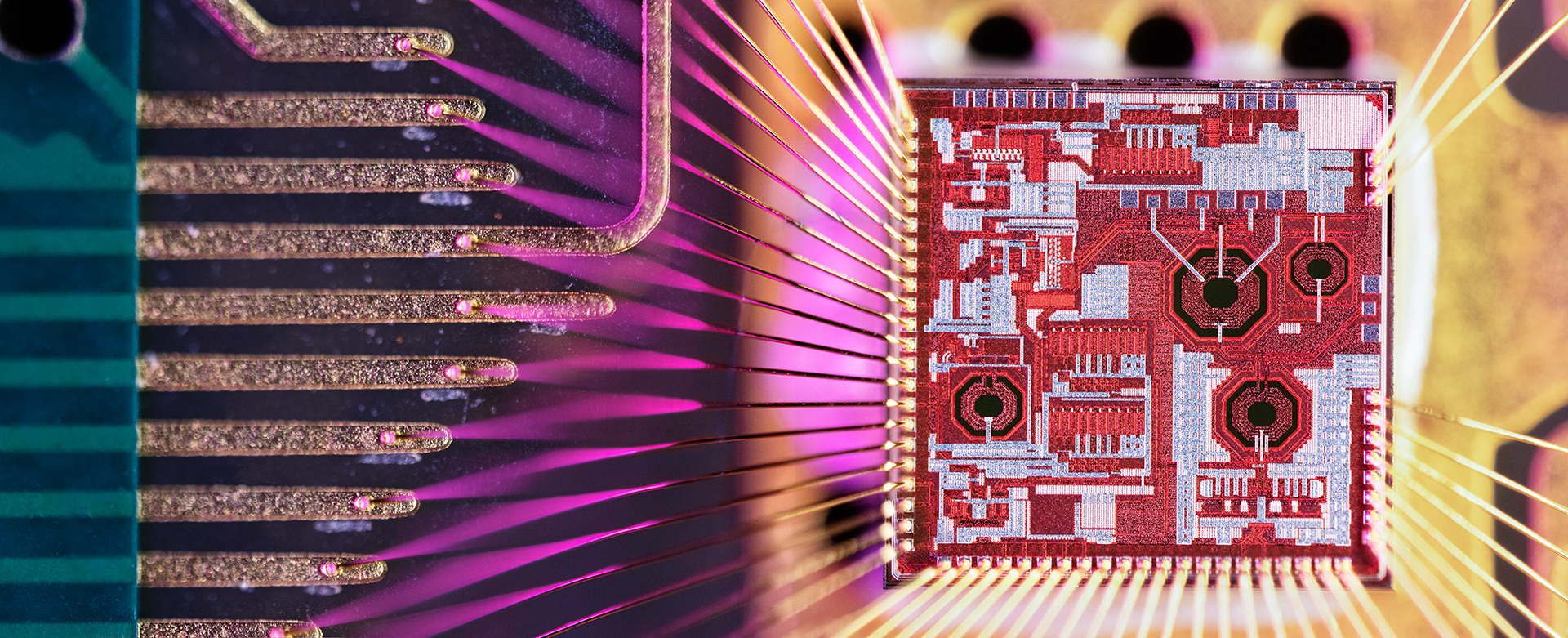
*In Memoriam: Fucheng Yin
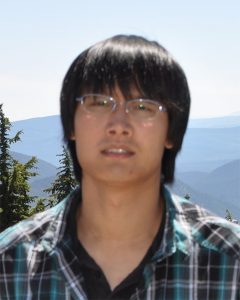
UW ECE alumnus Fucheng Yin (BSEE ‘18, MSEE ‘21). Photo provided by the Future Analog Systems Technologies Lab.
UW ECE would like to express our deepest condolences to the family and friends of Fucheng Yin. Fucheng was a co-author of the IEEE Journal of Solid-State Circuits paper described in the above article and an important member of Professor Rudell’s graduate student research group.
Fucheng was born in Guangzhou, Guangdong, China, in 1989. He received his bachelor’s and master’s degrees from UW ECE in 2018 and 2021, respectively. During the summer of 2021, he held an intern position with the Radio Frequency (RF) Group at Impinj in Seattle. In January 2022, he joined Qualcomm in Santa Clara, California, as an RF Integrated Circuit (IC) Designer.
As a UW ECE graduate student, Fucheng was extremely committed to research and teaching. His research interests included the area of radio frequency and millimeter-wave integrated circuit design, electromagnetics, and device physics. He was well liked by the faculty and his fellow students.
Fucheng passed away in 2022 after a long and courageous battle with an illness. He had expressed to his family, friends, and colleagues that it was a lifelong dream of his to publish a research paper in an IEEE Journal. With the paper described in this article, he not only accomplished that goal but also was posthumously a co-recipient of the Best Student Paper Award at the 2022 IEEE European Solid-State Circuits Conference for this work related to his master’s thesis.
All of us at UW ECE, including Professor Rudell and his graduate student research group, are very grateful to Fucheng for his collegiality and many contributions to the classroom and the lab over the years. He will be greatly missed.

